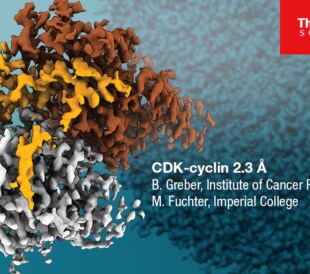Bringing cryo-electron microscopy to human biology research
Human Technopole—Italy’s new institute for integrative human biology research—installed its first cryo-electron microscopes this year following many months of planning, development, construction, and accelerated research projects.
Home to a Thermo Scientific Krios G4 Cryo-TEM, Glacios Cryo-TEM, Talos L120C TEM, Spectra 300 (S)TEM and Aquilos 2 Cryo FIB, this impressive facility will enable correlative microscopy and enhanced life science research, with a particular focus on developing novel approaches for personalized and preventative medicine.
Demystifying cellular machinery with cryo-EM
Following nearly 10 years as a research group leader at the Max Planck Institute, Gaia Pigino joined Human Technopole as its first associate head of the Structural Biology Research Centre. She is also the leader of her research team, the Pigino Group.
“Human Technopole is a very exciting new opportunity for me and my team, having made a major investment in electron and light microscopy technologies,” shared Pigino in a recent video interview with Thermo Fisher Scientific. “Now, we have access to a number of microscopes to do cryo-CLEM and cryo-FIB, which we will use to address an all-new range of questions in structural cellular biology.”
Pigino’s lab uses cryo-EM and cryo-electron tomography (cryo-ET) to uncover the structural organization and the function of protein complexes within cilia and eukaryotic flagella.
Cilia and flagella are slender cellular projections present almost ubiquitously across the eukaryotic tree of life. These organelles use specially arranged microtubules for their internal structure and as tracks to transport proteins to and from their tips. They are important for motility and signaling and their dysfunctions result in human developmental disorders and diseases affecting multiple organ systems.
“The overarching goal of my lab is to investigate the assembly and function of large cellular machinery. We focus our research on the biology of cilia and flagella. We use an integrative approach to unravel the molecular mechanisms that allow individual proteins to find their correct position along ciliary microtubules,” said Pigino.
Molecular insights drive human biology research
Recent research from the Pigino Group demonstrates the function of tubulin modifications for the motility of sperm flagella, and their importance for male fertility. The researchers’ findings show that tubulin glycylation regulates the beat of mammalian flagella by modulating the activity of axonemal dyneins, the molecular motors required to generate the beating motion of the flagellum. Lack of glycylation leads to perturbed sperm motility and male subfertility.
“We want to understand structure and function of cellular processes that are relevant for human health across scales. We can do this now here at Human Technopole,” she said. “We can go from following the activity of macromolecular complexes by light microscopy to investigating their molecular structures within cells by cryo-ET or in isolation at higher resolution by single particle analysis to X-ray crystallography. We can cover the complete range of resolution.”
Correlative microscopy at Human Technopole
The Pigino group joins an impressive team at Human Technopole, including Iain Mattaj, director of Human Technopole, Paolo Swuec, head of the Cryo-Electron Microscopy Facility, and Alessandro Vannini, head of the Structural Biology Research Center and leader of the Vannini Group.
“Human Technopole is created to carry out and enable research into human biology. We hope that by doing this, we’ll contribute to human health and wellbeing,” said Mattaj.
“We had to build everything from scratch, and our key priority was to establish a network of instruments integrated to each other, that is why we opted for the Thermo Scientific package,” added Swuec.
According to the Human Technopole team, cryo-EM is the structural biology technique in today’s day and age. “Without knowing the shape and form and how macromolecular machines work, we do not understand how life works,” said Vannini.
By bringing such an array of the most advanced life science technologies under one roof, Human Technopole aims to break barriers and maximize interactions between scientists across fields of study.
“We want to answer biological questions of such a breadth that only by maximizing these interactions can we really take this on,” said Vannini.
Check out our on-demand webinar with Gaia Pigino—Towards a mechanistic understanding of motile and primary cilia with CLEM, cryo-electron tomography and expansion microscopy >>
//
Brianna Radicioni is a Senior Marketing Communications Specialist at Thermo Fisher Scientific




Leave a Reply